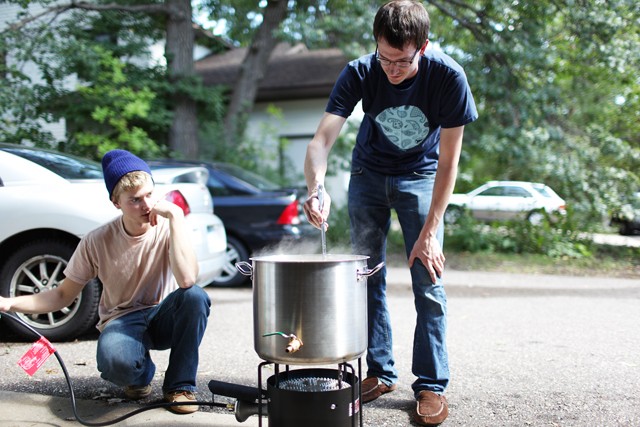He used a comically oversized metal spoon to pour the brown, sugary ooze into an eight-gallon kettle. Then, staring into the bubbling mixture of grains and water, University of Minnesota graduate Jon Duesterhoeft smiled.
“Look at that beautiful color.”
Duesterhoeft was preparing to brew a type of beer called barleywine, which has a higher than usual alcohol content. He’s made more than 50 different batches of beer over the past four years.
Although he typically brews in his apartment, Duesterhoeft was using a friend’s equipment and backyard in Falcon Heights for this batch of beer.
The friend, University student Martin Menart, owns a kettle and the “Bayou Classic,” a large propane burner used to heat the brew.
It is the Classic’s virgin run, Menart said, and it’s good they’re not using it in the house.
“If you did this inside you’d probably get a bunch of combustion fumes like people who kill themselves in their car,” he said.
Despite the danger, brewing beer piqued the interest of everybody who walks by. Duesterhoeft said there is also interest in homebrewing among his University co-workers, many of whom are fellow brewers.
But it’s not the people that make it worthwhile, he said. “It’s all about the beer. The social [aspect] is the bonus.”
For homebrewers, brewing beer is more about quality than price.
Menart said he had sunk about $600 into the hobby. Duesterhoeft just laughed.
The two said they’ve gained knowledge through experience, reading books and blogs and talking to fellow brewers.
For less-educated brewers, Minnesota Home Brewers Association president Chris Smith said joining a club is an excellent way to gain experience.
“My brewing went from making mediocre beers to making award-winning beers,” he said. “It’s just the flow of information.”
Newbies can bring in samples for more experienced members to critique, and learn about more advanced techniques in the process.
MHBA membership ranges from 200 to 250 yearly, Smith said.
In his friend’s equipment-strewn driveway, Duesterhoeft has heated the grains, added sugar and boiled the hops. It was time to cool the mixture for fermentation. Then, the only thing left was to add yeast and bottle the brew.
“I’ve got a new baby,” Duesterhoeft said.
Duesterhoeft said he originally began brewing because it seemed interesting, but he looked fairly seriously for jobs in the industry after graduation.
“I guess if I ended up in a brewery, I’d be alright with it,” Menart said.
Duesterhoeft agreed, “I think it goes through everybody’s mind that does this.”

Jon Duesterhoeft, right, and Martin Menart, left, stand around their Bayou Classic in St. Paul Sunday.
Brew it yourself: for the love of beer
University students are among Minneapolis’ growing number of backyard brewers.
by James Nord
Published September 16, 2010
0
More to Discover







